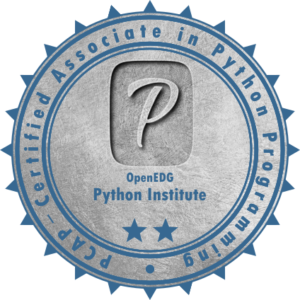Python Flow Chart
Course Length: 3 days
Course Overview
Python® continues to be a popular programming language, perhaps owing to its easy learning curve, small code footprint, and versatility for business, web, and scientific uses. Python is useful for developing custom software tools, applications, web services, and cloud applications. In this course, you'll build upon your basic Python skills, learning more advanced topics such as object-oriented programming patterns, development of graphical user interfaces, data management, creating web service-connected apps, performing data science tasks, unit testing, and creating and installing packages and executable applications.
Course Objectives
In this course, you will expand your Python proficiencies. You will:
- Select an object-oriented programming approach for Python applications.
- Create object-oriented Python applications.
- Create a desktop application.
- Create data-driven applications.
- Create and secure web service-connected applications.
- Program Python for data science.
- Implement unit testing and exception handling.
- Package an application for distribution.
Target Audience
This course is designed for existing Python programmers who have at least one year of Python experience and who want to expand their programming proficiency in Python 3.
Prerequisites
To ensure your success in this course, you should have experience with object-oriented programming and Python 2.x or 3.x. You can obtain this level of skills and knowledge by taking the following course:
Course Outline
Lesson 1: Selecting an Object-Oriented Programming Approach for Python Applications
- Topic A: Implement Object-Oriented Design
- Topic B: Leverage the Benefits of Object-Oriented Programming
Lesson 2: Creating Object-Oriented Python Applications
- Topic A: Create a Class
- Topic B: Use Built-in Methods
- Topic C: Implement the Factory Design Pattern
Lesson 3: Creating a Desktop Application
- Topic A: Design a Graphical User Interface (GUI)
- Topic B: Create Interactive Applications
Lesson 4: Creating Data-Driven Applications
- Topic A: Connect to Data
- Topic B: Store, Update, and Delete Data in a Database
Lesson 5: Creating and Securing a Web Service-Connected App
- Topic A: Select a Network Application Protocol
- Topic B: Create a RESTful Web Service
- Topic C: Create a Web Service Client
- Topic D: Secure Connected Applications
Lesson 6: Programming Python for Data Science
- Topic A: Clean Data with Python
- Topic B: Visualize Data with Python
- Topic C: Perform Linear Regression with Machine Learning
Lesson 7: Implementing Unit Testing and Exception Handling
- Topic A: Handle Exceptions
- Topic B: Write a Unit Test
- Topic C: Execute a Unit Test
Lesson 8: Packaging an Application for Distribution
- Topic A: Create and Install a Package
- Topic B: Generate Alternative Distribution Files
You may also be interested in:
Certification

There are three levels of certification available through the Python Institute Open Education and Development Group.
Certified Entry Level Python Programmer: Exam PCEP-30-01
Certified Associate in Python Programming: Exam PCAP-31-02
Certified Professional in Python Programming Exams: PCPP-32-101 and PCPP-32-201
For More information please see : https://pythoninstitute.org/certification/
